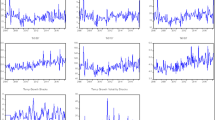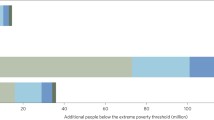Abstract
Weather is an integral part of our life and weather shocks can have severe implications on welfare. Given evidence that points to climate change resulting in altered patterns of weather parameters and given that the Philippines is one of the most vulnerable countries to climatic shifts, this paper aims to contribute to poverty studies in the country by analyzing the poverty-rainfall shock nexus. The paper finds that rainfall shocks affect wages and income, which in turn, affect chronic total and chronic food poverty. Some policy directions are provided.
Similar content being viewed by others
Notes
While evidence points to the adverse effects of weather shocks, there is a strand of literature at the macroceconomic level that emphasizes creative destruction. In this literature, extreme weather events have positive impact on capital and output growth. For example, Skidmore and Toya (2002) find that climatic disasters are associated with higher long run economic growth while geologic disasters are negatively associated with growth while Noy and Vu (2010) show that disasters that destroy more properties and capital boost the economy in the short-run.
Mansur et al. (2008) used this formulation in the context of energy consumption.
\(\bar{Q}_{x} (p_{x} ,b_{x} ,y,s,e) = - \frac{{\partial \bar{v}(p_{x} ,b_{x} ,y,s,e)/\partial p_{x} }}{{\partial \bar{v}(p_{x} ,b_{x} ,y,s,e)/\partial y}}\).
OLS assumption \(\text{cov} (Y,\varepsilon ) = 0\) is violated.
The authors would like to thank one of the referee for pointing this out.
For completeness, all the results are presented but the analysis revolves around those that pass the endogeneity and identification tests.
Specification 1 includes the proxy for rainfall shocks only and results show that rainfall shocks significantly explain chronic and transient poverty. Specification 2 enhances specification 1 by including the squared term of rainfall shocks to account for nonlinear effects. However, estimates pertaining to the squared term are not significantly different from zero and the results are not substantially different from specification 1.
This is the basic political unit in the Philippines, equivalent to a village.
As an illustration, Palawan province, located in Luzon’s Region 4A, has three stations, namely, Coron, Cuyo and Puerto Princesa. In this case, Puerto Princesa is chosen.
For example, Mountain Province and the provinces of La Union and Ifugao are assigned the weather station in Baguio City, Benguet while Tarlac is assigned the weather station in Cabanatuan, Nueva Ecija.
While three sets of estimations are done separately using weights in the 2003, 2006, and 2009 FIES, results presented here are estimates using the 2009 weights. Results across weights are relatively similar and estimates using the latest weights are presented due to space considerations. The full results are available from the corresponding author upon request.
References
Albert, J., & Dacuycuy, C. (2017). Evaluation and assessment of the effectiveness of the Department of Social Welfare and Development internal and external convergence as operationalized by the Regional, Provincial, and City/Municipal Action Teams. PIDS Discussion Paper Series 2017-32. Quezon City, Philippines.
Aldaba, F. (2009). Poverty in the Philippines: Causes, consequences and opportunities. Mandaluyong: Asian Development Bank Report.
Asian Development Bank. (2017). A region at risk: The human dimensions of climate change in Asia and the Pacific. Ortigas, Philippines.
Baez, J., Lucchetti, L., Genoni, M., & Salazar, M. (2015). Gone with the storm: Rainfall shocks and household well-being in Guatemala. IZA Discussion Paper No. 8792. Bonn, Germany.
Balisacan, A. (2003a). Poverty and inequality. In A. Balisacan & H. Hill (Eds.), The Philippine economy: Development, policies, and challenges. New York: Oxford University Press.
Balisacan, A. (2003b). Poverty comparison in the Philippines: Is what we know about the poor robust? In C. Edmonds (Ed.), Reducing poverty in Asia: Emerging issues in growth, targeting, and measurement. Cheltenham: Edward Elgar.
Balisacan, A., & Pernia, E. (2002). The rural road to poverty reduction: Some lessons from the Philippine experience. Journal of Asian and African Studies, 37, 147–167.
Bayani-Arias, J. K., & Palanca-Tan, R. (2017). Analyzing the relationship between exposure to extreme weather and economic inequality in the Philippines. Journal of Economics, Management Agricultural Development, 3(1), 27–39.
Bayudan-Dacuycuy, C. (2013). The influence of living with parents on women’s decision making participation in the household: Evidence from the Southern Philippines. The Journal of Development Studies, 49(5), 641–656.
Bayudan-Dacuycuy, C. (2017). Energy consumption, weather variability, and gender in the Philippines: A discrete/continuous approach. PIDS Discussion Paper Series 2017-06. Quezon City, Philippines.
Bayudan-Dacuycuy, C., & Lim, J. (2013). Family size, household shocks and chronic and transient poverty in the Philippines. Journal of Asian Economics, 29, 101–112.
Bayudan-Dacuycuy, C., & Lim, J. (2014). Chronic and transient poverty and vulnerability to poverty in the Philippines: Evidence using a simple spells approach. Social Indicator Research, 118, 389–413.
Davies, M., Guenther, B., Leavy, J., Mitchell, T., & Tanner, T. (2009). Climate change adaptation, disaster risk reduction and social protection: Complementary roles in agriculture and rural growth? IDS Working Paper No. 320. Brighton, United Kingdom: The Institute of Development Studies.
Deaton, A. (1997). The analysis of household surveys: Microeconomic analysis for development (p. 480p). Baltimore: Johns Hopkins University Press.
Deaton, A., & Zaidi, S. (2002). Guidelines for constructing consumption aggregates for welfare analysis. World Bank LSMS Working Paper Number 135. Washington DC, USA.
Deschenes, O., & Greenstone, M. (2007). The economic impacts of climate change: Evidence from agricultural output and random fluctuations in weather. The American Economic Review, 97(1), 354–385.
Devicienti, F. (2002). Estimating poverty persistence in Britain. Center for Employment Studies Working Paper Series No. 1. LABORatorio Riccardo Revelli, Collegio Carlo Alberto, Italy.
Duclos, J., Araar, A., & Giles, J. (2010). Chronic and transient poverty: Measurement and estimation, with evidence from China. Journal of Development Economics, 91, 266–277.
Duncan, G., & Rodgers, W. (1991). Has children’s poverty become more persistent? American Sociological Review, 56, 538–550.
Eckstein, D., Künzel, V., & Schäfer, L (2018). Global climate risk index 2018: Who suffers most from extreme weather events? Weather-related loss events in 2016 and 1997 to 2016. Germanwatch. https://reliefweb.int/sites/reliefweb.int/files/resources/20432.pdf.
Fitzgerald, J., Gottschalk, P., & Moffit, R. (1998). An analysis of sample attrition in panel data. Journal of Human Resources, 33(2), 251–299.
Haddad, L., & Ahmed, A. (2003). Chronic and transitory poverty: Evidence for Egypt, 1997-99. World Development, 31, 71–85.
Hallegate, S., Fay, M., & Barbier, E. (2018). Poverty and climate change: Introduction. Environment and Development Economics, 23, 217–233.
Handa, S. (1996). Expenditure behavior and children’s welfare analysis of female headed households in Jamaica. Journal of Development Economics, 50, 165–187.
Intal, P. (1994). The state of poverty in the Philippines: An overview. In P. S. Intal Jr. & M. C. S. Bantilan (Eds.), Understanding poverty and inequity in the Philippines. Pasig: National Economic and Development Authority.
Jalan, J., & Ravallion, M. (1998). Transient poverty in postreform rural China. Journal of Comparative Economics, 26, 338–357.
Kuriakose, A., Heltberg, R., Wiseman, W., Costella, C., Cipryk, R., & Cornelius, S. (2012). World Bank climate-responsive social protection. Discussion Paper No. 1210. Washington DC, USA.
Levine, D., & Yang, D. (2014). The impact of rainfall on rice output in Indonesia. NBER Working Paper 20302. Massachusetts, CA.
Lillard, L., & Willis, R. (1978). Dynamic aspects of earnings mobility. Economica, 46, 985–1012.
Maccini, S., & Yang, D. (2009). Under the weather: Health, schooling, and economic consequences of early-life rainfall. The American Economic Review, 99(3), 1006–1026.
Mansur, E., Mendelsohn, R., & Morrison, W. (2008). Climate change adaptation: A study of fuel choice and consumption in the US energy sector. Journal of Environmental Economics and Management, 55(2), 175–193.
Mina, C., & Imai, K. (2016). Estimation of vulnerability to poverty using a multilevel longitudinal model: Evidence from the Philippines. Journal of Development Studies. https://doi.org/10.1080/00220388.2016.1265942.
National Economic Development Authority. (2017). Philippine Development Plan 2017–2022. Pasig City.
Noy, I., & Vu, T. (2010). The economics of natural disasters in a developing country: The case of Vietnam. Journal of Asian Economics, 21, 345–354.
Olsson, L., Opondo, M., Tschakert, P., Agrawal, A., Eriksen, S., Ma, S., et al. (2014). Livelihoods and poverty. In C. B. Field, V. R. Barros, D. J. Dokken, K. J. Mach, M. D. Mastrandrea, T. E. Bilir, M. Chatterjee, K. L. Ebi, Y. O. Estrada, R. C. Genova, B. Girma, E. S. Kissel, A. N. Levy, S. MacCracken, P. R. Mastrandrea, & L. L. White (Eds.), Climate change 2014: Impacts, adaptation, and vulnerability. Part A: Global and sectoral aspects. (pp. 793–832)., Contribution of Working Group II to the Fifth Assessment Report of the Intergovernmental Panel on Climate Change Cambridge: Cambridge University Press.
Quisumbing, A., & Maluccio, J. (2003). Resources at marriage and intrahousehold allocation: Evidence from Bangladesh, Ethiopia, Indonesia, and South Africa. Oxford Bulletin of Economics and Statistics, 65(3), 283–327.
Safir, A., Piza, S., & Skoufias, E. (2013). Disquiet on the weather front: The welfare impacts of climatic variability in the rural Philippines. World Bank Policy Research Working Paper 6579. Washington DC, USA.
Samuelson, P. (1974). Complementarity: An essay on the 40th anniversary of the Hicks-Allen revolution in demand theory. Journal of Economic Literature, 12(4), 1255–1289.
Skidmore, M., & Toya, H. (2002). Do natural disasters promote long-run growth? Economic Inquiry, 40(4), 664–687.
Skoufias, E., Katayama, R., & Essama-Nssah, B. (2012). Too little too late: Welfare impacts of rainfall shocks in rural Indonesia. Bulletin of Indonesian Studies, 48(3), 351–368.
Skoufias, E., Vinha, K., & Conroy, H. (2011). The impacts of climate variability on welfare in Rural Mexico. World Bank Policy Research Working Paper 5555. Washington DC, USA.
Thomas, T., Christiansen, L., Do, Q., & Trung, L. (2010). Natural disasters and household welfare: Evidence from Vietnam. World Bank Policy Research Working Paper Number 5491. Washington DC, USA.
Wolpin, K. (1982). A new test of the permanent income hypothesis: The impact of weather on the income and consumption of farm households. International Economic Review, 23(3), 583–594.
Yang, D., & Choi, H. (2007). Are remittances insurance? Evidence from rainfall shocks in the Philippines. The World Bank Economic Review, 21(2), 219–248.
Author information
Authors and Affiliations
Corresponding author
Additional information
Publisher's Note
Springer Nature remains neutral with regard to jurisdictional claims in published maps and institutional affiliations.
Rights and permissions
About this article
Cite this article
Bayudan-Dacuycuy, C., Baje, L.K. When It Rains, It Pours? Analyzing the Rainfall Shocks-Poverty Nexus in the Philippines. Soc Indic Res 145, 67–93 (2019). https://doi.org/10.1007/s11205-019-02111-1
Accepted:
Published:
Issue Date:
DOI: https://doi.org/10.1007/s11205-019-02111-1




